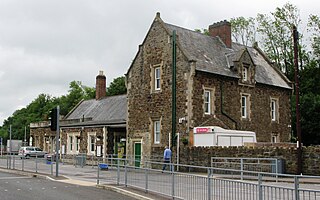
Bideford is a historic port town on the estuary of the River Torridge in north Devon, South West England. It is the main town of the Torridge local government district.

Great Torrington is a market town in Devon, England. Parts of it are sited on high ground with steep drops down to the River Torridge below, with the lower-lying parts of the town prone to occasional flooding. Torrington is in the centre of Tarka Country, a landscape captured by Henry Williamson in his novel Tarka the Otter in 1927. Great Torrington has one of the most active volunteering communities in the United Kingdom.

Barnstaple is a river-port town and civil parish in the North Devon district of Devon, England. The town lies at the River Taw's lowest crossing point before the Bristol Channel. From the 14th century, it was licensed to export wool from which it earned great wealth. Later it imported Irish wool, but its harbour silted up and other trades developed such as shipbuilding, foundries and sawmills. A Victorian market building survives, with a high glass and timber roof on iron columns.

North Devon is a local government district in Devon, England. Its council is based just outside Barnstaple, the district's largest town. The district also includes the towns of Ilfracombe, Lynton and Lynmouth and South Molton along with numerous villages, seaside resorts and surrounding rural areas.

Derby Museum and Art Gallery is a museum and art gallery in Derby, England. It was established in 1879, along with Derby Central Library, in a new building designed by Richard Knill Freeman and given to Derby by Michael Thomas Bass. The collection includes a gallery displaying many paintings by Joseph Wright of Derby; there is also a large display of Royal Crown Derby and other porcelain from Derby and the surrounding area. Further displays include archaeology, natural history, geology, military collections and world cultures. The Art Gallery was opened in 1882.

Manchester Art Gallery, formerly Manchester City Art Gallery, is a publicly owned art museum on Mosley Street in Manchester city centre, England. The main gallery premises were built for a learned society in 1823 and today its collection occupies three connected buildings, two of which were designed by Sir Charles Barry. Both of Barry's buildings are listed. The building that links them was designed by Hopkins Architects following an architectural design competition managed by RIBA Competitions. It opened in 2002 following a major renovation and expansion project undertaken by the art gallery.

Fremington is a large village, civil parish and former manor in North Devon, England, the historic centre of which is situated three miles (5 km) west of Barnstaple. The village lies between the south bank of the tidal estuary of the River Taw and a small inlet of that river known as Fremington Pill. The parish is surrounded clockwise from the north by the parishes of Heanton Punchardon, Ashford, West Pilton, Barnstaple, Tawstock, Horwood, Lovacott and Newton Tracey, and Instow.

Crediton railway station is a railway station serving the town of Crediton in Devon, England. It is 7 miles 76 chains (12.8 km) from Exeter Central at milepost 179.25 from London Waterloo.

Yeoford railway station is a rural station serving the village of Yeoford in Devon, England. It is on the Tarka Line to Barnstaple, 11 miles 42 chains (18.5 km) from Exeter Central at milepost 183 from London Waterloo.

Barnstaple railway station is the northern terminus of the Tarka Line and serves the town of Barnstaple, Devon. It is 39 miles 75 chains (64.3 km) from Exeter Central and 211.25 miles (339.97 km) from London Waterloo. It is managed by Great Western Railway, which also operates the passenger service.

The Royal Devon Yeomanry was a Yeomanry regiment of the British Army, formed in 1920. It participated in the Second World War and now forms a squadron of the Royal Wessex Yeomanry.

The National Museum of Indonesia is an archeological, historical, ethnological, and geographical museum located in Jalan Medan Merdeka Barat, Central Jakarta, right on the west side of Merdeka Square. Popularly known as the Elephant Museum after the elephant statue in its forecourt, its broad collections cover all of Indonesia's territory and almost all of its history. The museum has endeavoured to preserve Indonesia's heritage for two centuries.

The National Museum of Scotland in Edinburgh, Scotland is a museum of Scottish history and culture.

The Bangkok National Museum is the main branch museum of the National Museums in Thailand and also one of the largest museums in Southeast Asia. It features exhibits of Thai art and history. It occupies the former palace of the vice king, set between Thammasat University and the National Theater, facing Sanam Luang.
In countries whose armies are organised on a regimental basis, such as the army of the United Kingdom, a regimental museum is a military museum dedicated to the history of a specific army regiment.
Shapland & Petter were architectural doorset manufacturers in Barnstaple, Devon, England before being taken over by the LS Group in 1999. Before takeover, Shapland & Petter was the largest privately owned employer in Devon, with a staff of approximately 900 during the 1990s. All operations at Barnstaple finally ceased in 2016 as the LS Group was wound up and the riverfront site was earmarked for redevelopment as a superstore.

Kingston Museum is an accredited museum in Kingston upon Thames, southwest London, England. The Scottish-American philanthropist Andrew Carnegie funded the building of the museum, which adjoins Kingston Library.
The Royal North Devon Yeomanry was a Yeomanry regiment of the British Army. First raised in 1798, it participated in the Second Boer War and the First World War before being amalgamated with the Royal 1st Devon Yeomanry in 1920 to form the Royal Devon Yeomanry.

The Bear Street drill hall is a former military installation in Barnstaple, Devon. It is a Grade II listed building.



























